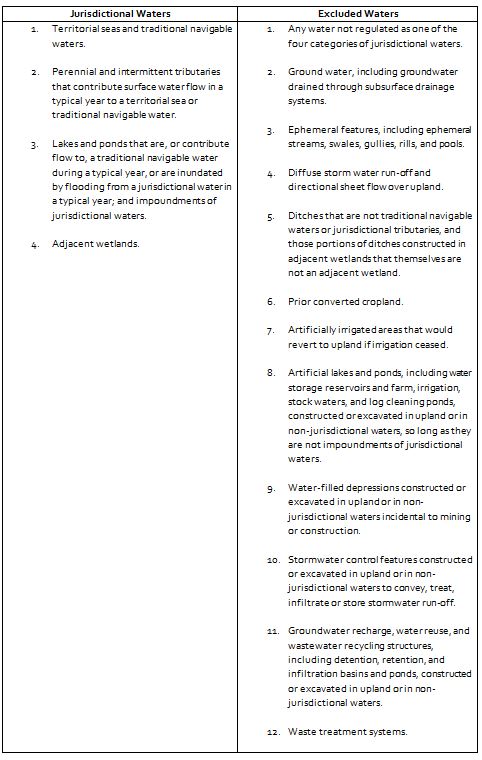On January 23, 2020, the Environmental Protection Agency (“EPA”) and the U.S. Army Corps of Engineers (the “Corps”) (collectively the “Agencies”) released a final rule re-defining the term “waters of the United States” as applied under the Clean Water Act (“Final Rule”).
The Final Rule substantially narrows the scope of waterbodies subject to regulation under the Clean Water Act—notably removing interstate streams as a separate jurisdictional category; excluding ephemeral streams and water features; requiring rivers, streams and other natural channels to directly or indirectly contribute flow to a territorial sea or traditional navigable water; and excluding wetlands that are not adjacent to another non-wetland jurisdictional water. Further, the Agencies confirm that groundwater is not subject to regulation under the Clean Water Act and, consequently, that surface water features connected only via groundwater likewise are not jurisdictional. In support of this narrower scope, the Agencies explain that states and tribes retain the authority to regulate non-jurisdictional waters within their authority, provided those states and tribes deem such regulation appropriate.
The Final Rule replaces the definition of “waters of the United States” adopted under a 2015 Obama-era “WOTUS Rule” (the “2015 WOTUS Rule”), which was formally repealed by the Agencies on October 22, 2019. As explained in previous Van Ness Feldman alerts, the 2015 WOTUS Rule expanded federal control over several types of waterbodies, particularly with respect to tributaries, adjacent waters, and wetlands. 2015 WOTUS Rule has been subject to numerous legal challenges. These challenges resulted in a patchwork regulatory regime where application of the 2015 WOTUS Rule was enjoined from implementation in 28 states, while the remaining 22 states were subject to the more expansive regulatory definition of the “waters of the United States.”
The Agencies have described the Final Rule as providing “consistency, predictability, and clarity,” as well as appropriately recognizing state and tribal regulatory authority. The Final Rule pulls from three Supreme Court opinions in United States v. Riverside Bayview Homes (Riverside Bayview), Solid Waste Agency of Northern Cook County v. United States (SWANCC), and Rapanos v. United States (Rapanos) to adopt a unifying legal theory to define “waters of the United States” based on sufficient surface water connections with downstream traditional navigable waters and territorial seas. In adopting a unifying interpretive approach, the Agencies explicitly eliminate the case-specific application of their previous interpretation of Justice Kennedy’s significant nexus test in what was called their “Rapanos Guidance.”
Under the Final Rule, the overall categories of jurisdictional and excluded waters, in many ways, are similar to the existing regulatory scheme. As a practical matter, however, the Final Rule substantially narrows the scope of waterbodies subject to regulation under the Clean Water Act. The Agencies classify jurisdictional and excluded waters as follows:
The Agencies will primarily rely on states and tribes to regulate non-jurisdictional waters within their authority, provided those states and tribes deem such regulation appropriate.
Among the Final Rule’s most significant changes from the 2015 WOTUS Rule’s definition of federally regulated waters of the United States are the exclusions of ephemeral streams and wetlands that are not adjacent to another non-wetland jurisdictional water. Another notable element is the Agencies’ confirmation that groundwater is not subject to regulation under the Clean Water Act and, consequently, that surface water features connected only via groundwater likewise are not jurisdictional.
The Final Rule also provides definitions for key terms and offers guidance on their intended application of the regulated and non-regulated categories of waters. Key issues addressed by the Agencies include:
-
“Tributary” is defined as a river, stream, or similar naturally occurring surface water channel that contributes surface water flow to a territorial sea or traditional navigable water in a typical year directly or through another jurisdictional water. A tributary must be perennial or intermittent in a typical year. The Agencies also explain that a tributary does not lose its jurisdictional status if it contributes surface water flow to a downstream jurisdictional water in a typical year through a channelized non-jurisdictional surface water feature, through a subterranean river, culvert, dam, tunnel or similar artificial feature, or through a debris pile, boulder field or similar natural features. Tributaries include ditches that relocate a tributary, were constructed in a tributary, or are constructed in an adjacent wetland and have surface flow to the downstream jurisdictional water.
-
Certain delineation determinations will require the presence of the necessary jurisdictional features in a “typical year,” i.e., defined as “when precipitation and other climatic variables are within the normal periodic range (e.g. seasonally, annually) for the geographic area of the applicable aquatic resource based on a rolling thirty-year period.”
-
Ditches are not included as a separate category of jurisdictional waters, but instead are included in the definition of tributary. Ditches that are constructed in, or that relocate, a tributary or that are constructed in adjacent wetlands are included as a tributary and are jurisdictional if the flow in the ditch is perennial or intermittent during a typical year and that flow reaches a traditional navigable water or territorial sea. The Preamble notes that the majority of ditches used to drain surface and shallow subsurface water from croplands are expected to be non-jurisdictional.
-
Lakes, ponds and other impoundments do not lose their jurisdictional status if they contribute surface water flow to a downstream jurisdictional water through a culvert, dike, pipe, spillway, tunnel or other artificial feature or through a natural feature such as a debris pile or boulder field. However, lakes, ponds and impoundments that are connected downstream to jurisdictional waters only by diffuse stormwater runoff or directional sheet flow over upland areas are not jurisdictional. An ecological connection between a lake, pond or impoundment is insufficient to establish federal jurisdiction.
-
An impoundment must have a surface water connection to a downstream jurisdictional water in order to be regulated. The downstream surface water connection does not need to be natural but may be through any manner of artificial features (tunnels, culverts, spillways, etc.). However, lakes, ponds and impoundments that lose water only through evaporation, underground seepage or consumptive use are no longer considered jurisdictional waters.
-
Adjacent wetland are defined as wetlands that either: (i) abut a territorial sea, traditional navigable water, or regulated lake, pond, or impoundment; (ii) are inundated by flooding from one of these jurisdictional waters; (iii) are physically separated from one of these waters by a natural berm, bank, dune or similar natural feature; or (iv) are physically separated from one of these waters by an artificial dike, barrier or other structure, including a road, that allows for a direct hydrologic surface connection with the regulated water in a typical year (such as through a culvert, flood or tide gate, pump or similar feature). Application of these categories still requires further context to the relevant connections. For example, the Agencies explain that a subsurface connection through porous soils is insufficient to establish jurisdiction over a wetland separated by an artificial structure, such as a dike. Likewise, if the surface flow between the wetland and the abutting jurisdictional water across, or through, a dike or other artificial barrier only occurs after a 100-year storm event, this would not be sufficient to establish jurisdiction because the surface water connection would not occur once during a typical year. Finally, the Final Rule eliminates the prior definition of “adjacent”—which had included the terms “bordering, contiguous, or neighboring.” The elimination of the prior “adjacent” definition further limits the regulatory reach over wetlands under the Final Rule.
For each category of regulated waters, the Preamble in the Final Rule provides guidance on how the Final Rule will be implemented. Issues of implementation also are addressed in an “Implementation Statement” that was concurrently issued by the Agencies.
Lawsuits challenging this Final Rule are expected, likely resulting in continuing uncertainty, and, potentially, a further state-by-state patchwork of regulation, until these cases ultimately are addressed by the Supreme Court. For now, however, project and resource developers should carefully consider how the Final Rule may affect their permitting obligations for proposed development and work in or near waterbodies and wetlands.






 />i
/>i

